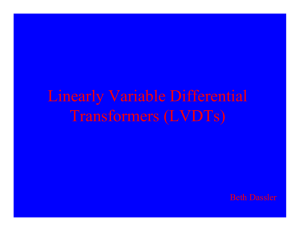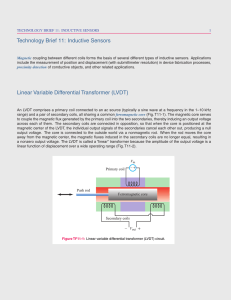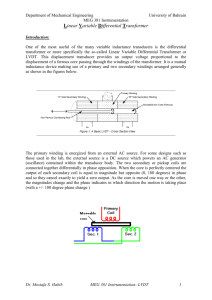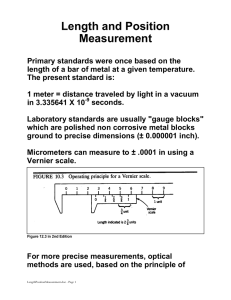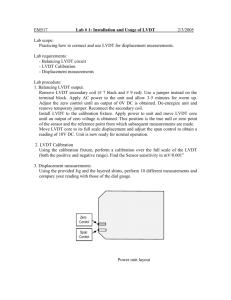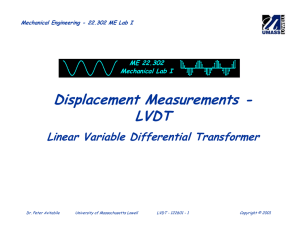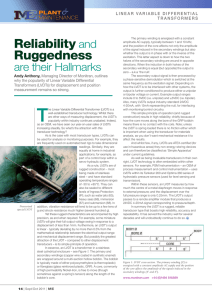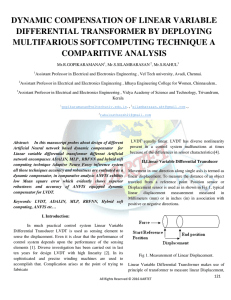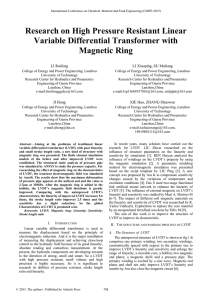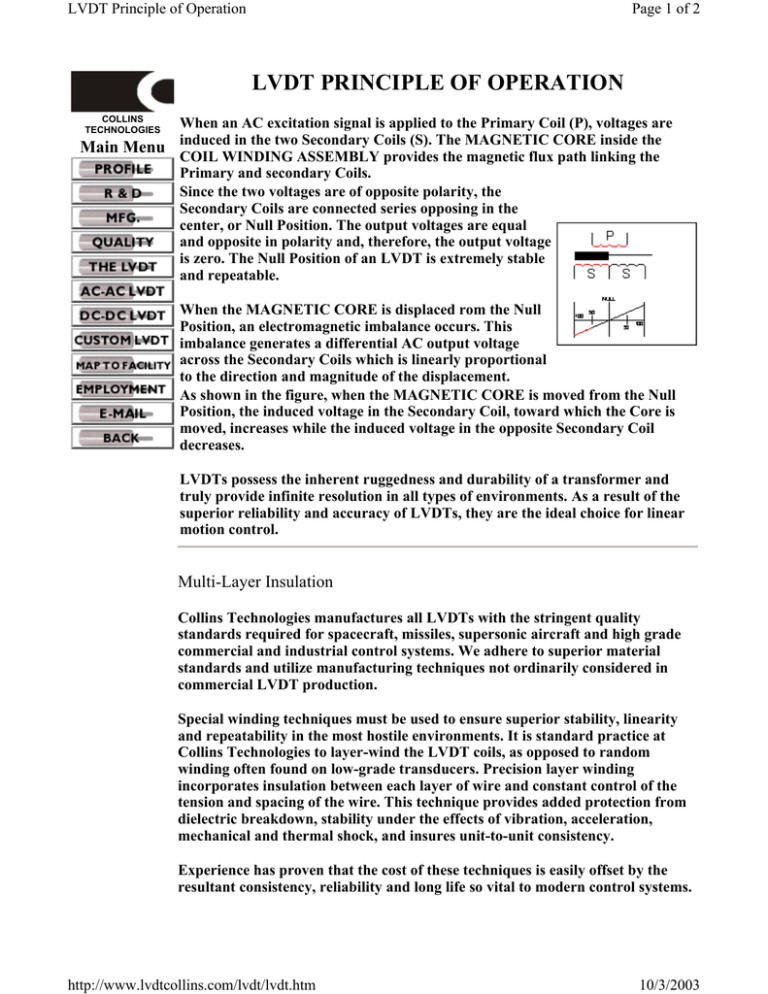
LVDT Principle of Operation
Page 1 of 2
LVDT PRINCIPLE OF OPERATION
COLLINS
TECHNOLOGIES
When an AC excitation signal is applied to the Primary Coil (P), voltages are
Main Menu induced in the two Secondary Coils (S). The MAGNETIC CORE inside the
COIL WINDING ASSEMBLY provides the magnetic flux path linking the
Primary and secondary Coils.
Since the two voltages are of opposite polarity, the
Secondary Coils are connected series opposing in the
center, or Null Position. The output voltages are equal
and opposite in polarity and, therefore, the output voltage
is zero. The Null Position of an LVDT is extremely stable
and repeatable.
When the MAGNETIC CORE is displaced rom the Null
Position, an electromagnetic imbalance occurs. This
imbalance generates a differential AC output voltage
across the Secondary Coils which is linearly proportional
to the direction and magnitude of the displacement.
As shown in the figure, when the MAGNETIC CORE is moved from the Null
Position, the induced voltage in the Secondary Coil, toward which the Core is
moved, increases while the induced voltage in the opposite Secondary Coil
decreases.
LVDTs possess the inherent ruggedness and durability of a transformer and
truly provide infinite resolution in all types of environments. As a result of the
superior reliability and accuracy of LVDTs, they are the ideal choice for linear
motion control.
Multi-Layer Insulation
Collins Technologies manufactures all LVDTs with the stringent quality
standards required for spacecraft, missiles, supersonic aircraft and high grade
commercial and industrial control systems. We adhere to superior material
standards and utilize manufacturing techniques not ordinarily considered in
commercial LVDT production.
Special winding techniques must be used to ensure superior stability, linearity
and repeatability in the most hostile environments. It is standard practice at
Collins Technologies to layer-wind the LVDT coils, as opposed to random
winding often found on low-grade transducers. Precision layer winding
incorporates insulation between each layer of wire and constant control of the
tension and spacing of the wire. This technique provides added protection from
dielectric breakdown, stability under the effects of vibration, acceleration,
mechanical and thermal shock, and insures unit-to-unit consistency.
Experience has proven that the cost of these techniques is easily offset by the
resultant consistency, reliability and long life so vital to modern control systems.
http://www.lvdtcollins.com/lvdt/lvdt.htm
10/3/2003
LVDT Principle of Operation
Page 2 of 2
The LVDT (Linear Variable
Differential Transformer) is an
electrometic device that produces an
electrical voltage proportional to the
displacement of a movable Magnetic
Core. The LVDT is composed of these
basic components:
A COIL WINDING ASSEMBLY
consisting of a Primary Coil and two
Secondary Coils symmetrically spaced
on a tubular center.
A CYLINDRICAL CASE which
encloses and protects the Coil Winding
Assembly.
A rod shaped MAGNETIC CORE
which is free to move axially within the
Coil Winding Assembly.
A separate shield is used for
ELECTROMAGNETIC SHIELDING.
Helpful Terms
a CURTISS-WRIGHT company
5875 Obispo Avenue, Long Beach, CA 90805 | (562) 531-6500 Fax: (562) 6339030
Copyright © Collins Technologies 2003, All rights reserved
This website designed and maintained by Townbiz
http://www.lvdtcollins.com/lvdt/lvdt.htm
10/3/2003

